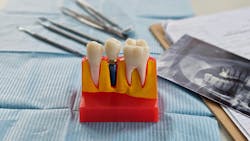What you'll learn in this article
- How early detection of peri-implant diseases improves treatment success and why three-month recare intervals help control biofilm around implant threads
- The role of annual baseline and follow-up radiographs—plus when CBCT is warranted—to monitor crestal bone levels and detect early bone loss
- How to evaluate implant mobility and distinguish between crown loosening and true implant compromise to prevent structural damage
- Evidence-based maintenance techniques, including air polishing with glycine powder, nonabrasive instrumentation, and adjunctive home-care tools such as occlusal night guards and water flossers with antimicrobial rinses
Listen to the article on our podcast!
Editor's note: This is part two of a two-part series. Read part one.
Early identification of peri-implant diseases increases the probability of slowing the progression of disease as well as initiating necessary treatment. It is estimated that approximately 15% of all implants will fail during the first 10 years.1 Educating patients on the risk factors and signs of peri-implant diseases will help reduce the risk of developing peri-implantitis. By working together as a team with the patient and dentist, dental hygienists play an integral role in preventing peri-implant diseases and decreasing the risk of failing implants. This is why routine implant maintenance is vital in preserving the health of dental implants.
Implant maintenance protocol has historically had areas of gray; studies can vary in the recommendations and “standard of care” for dental implants. The two most common areas of dispute are probing and instrument selection.
In 2017, the American Academy of Periodontology released a landmark report that identified periodontal classifications for peri-implant diseases and conditions, providing dentists and dental hygienists with easily identifiable clinical indications to help accurately assess the health of dental implants. The clinical symptoms of both peri-implant mucositis and peri-implantitis are similar; the key difference is radiographic bone loss.
With these guidelines in place, let’s take a closer look at how best to manage and treat dental implants on a routine basis.
Increase frequency of dental cleanings
Patients with dental implants should anticipate an increase in the frequency of dental cleanings per year. Recommending three-month maintenance appointments will allow dental hygienists to keep the bacterial loads under better control than at six-month intervals. Due to the anatomy of the dental implant, bacterial biofilm can accumulate around the implant threads, thus making the implant susceptible to peri-implant diseases. The objective of frequent recall appointments is for the prevention, early identification, and treatment of peri-implant diseases.
Yearly radiographs of dental implants
During the placement of dental implants, radiographs are taken throughout the procedure to ensure accurate placement of the implant. During the osseointegration period, images are also obtained periodically to monitor the healing process. Once the final implant crown is placed and the dental implant is bearing the full occlusal load, it is recommended that a final x-ray be taken to evaluate the site for a proper fit and/or cement retention. This final x-ray serves as a “baseline” for the dental implant. Radiographic evaluation should be completed a minimum of once per year to evaluate the height of crestal alveolar bone and the apex of the implant.2,3 Due to the limitations of periapical x-rays, concerns about possible bone loss may require more extensive imaging with cone-beam computed tomography (CBCT) to fully assess the health of the dental implant.
Evaluating for mobility
As part of the periodontal exam, it is necessary to evaluate each implant for mobility. Mobility can often indicate that the implant crown is loose or that there may be an underlying disease process around the dental implant. Radiographs can provide additional insight in conjunction with the oral assessment to determine if the mobility is due to the implant or the implant crown. If it is determined that there is no underlying disease, then a referral should be made to have the implant crown evaluated by the restoring dentist. A loose implant crown can cause extensive damage to the dental implant, significantly increasing the risk of fracture to the implant and potentially leading to failure.2
Oral hygiene education
Patients should be educated on the implications of poor oral hygiene on dental implants and the postsurgical outcomes that can occur. Often, patients who have dental implants have a history of periodontal disease or poor oral health care. This is why it is so important that patients are aware of the oral health-care expectations and the role that they play in successful implant outcomes.
Routine implant care strategies that can be administered in-office do not vary greatly from those for nonimplant patients. However, the key to implementing a successful dental implant therapy program is education and having the appropriate equipment available to the dental hygienist.
Air polishing
Air polishing has made tremendous advancements since its initial introduction in 1970. Air polishing has become one of the gold standards for debriding biofilm around dental implant threads. By design, the tight threading on the implant is not easily accessible with traditional hand instruments. Studies have indicated that the use of glycine powder in air polishers is more effective than curettes in reducing the risk of peri-implant disease. This is due to glycine powder’s superior ability to remove biofilm. There has also been a link between the use of glycine powder air polishing and a reduction in periodontal pocket depths around implants, bleeding upon probing, and improved plaque control.4
Manual hand instrumentation
Recent studies have demonstrated that air polishing provides superior biofilm removal compared to traditional instrumentation. Historically, plastic instruments that have been used to debride implants are bulky and inefficient. This area of implant maintenance is often murky and can lead to confusion for dental hygienists. The American College of Prosthodontics recommends using instruments that are composed of the same metal as the implants to avoid residual particles being deposited in the periodontium.5 Generally, it is best to use hand instruments that are nonabrasive to achieve the best treatment outcomes.
Educating patients about their oral health and developing good home-care habits is essential during any type of recare appointment. Throughout the entire implant process—from the initial assessment to the final restoration—home care should be addressed with the patient so that they are aware of the important role they play in maintaining their dental implant. In addition to the standard brushing and flossing expectation, additional adjuncts will help preserve the health of dental implants and the patient’s investment.
Occlusal night guards
It is recommended that patients with dental implants invest in an occlusal night guard. This is to limit the occlusal force on the implant as well as guarding against occlusal wear on the natural teeth. It is essential that dental implants do not have excess occlusal force as this can cause the implant to fail.
Water flossers
Water flossers can be effective for patients with both single and multiple dental implants. The use of the water flosser’s implant tip can provide better access around the implant and the associated restoration. This is especially useful for All-on-4 dentures and for implants that are difficult to floss and/or access. The use of medicinal rinses such as chlorhexidine in the water flosser is more effective at reducing the biofilm than just plain water. Studies have shown that the antimicrobial properties of chlorhexidine when used with water flossers can be beneficial in reducing biofilm and peri-implantitis.4,5 However, patients should be advised of the risk of interproximal staining and mucosal irritation when using chlorhexidine.
Establishing recare appointment standards for patients with dental implants can begin with the dental hygienist. Treatment outcomes often are the most successful and predictable when the patient understands the expectations and works as a team with the dental providers to achieve optimal health. Implementing change can be difficult in a dental office, but by offering information that is fact based, grounded in research, and proven, effective change can be achieved. When working with patients, dental hygienists should make individualized treatment recommendations that allow for optimum maintenance and a positive dental experience.
Editor's note: This article appeared in the August/September 2025 print edition of RDH magazine. Dental hygienists in North America are eligible for a complimentary print subscription. Sign up here.
References
- Jemt T. Implant failures and age at the time of surgery: a retrospective study on implant treatments in 4585 edentulous jaws. Clin Implant Dent Relat Res. 2019;21(4):514-520. doi:10.1111/cid.12753
- Gulati M, Govila V, Anand V, Anand B. Implant maintenance: a clinical update. Int Sch Res Notices. 2014;2014:908534. doi:10.1155/2014/908534
- Monje A, Aranda L, Diaz KT, et al. Impact of maintenance therapy for the prevention of peri-implant diseases: a systemic review and meta-analysis. J Dent Res. 2016;95(4):372-379. doi:10.1177/0022034515622432
- Araujo TG, Moreira CS, Neme RA, Luan H, Bertolini M. Long-term implant maintenance: a systemic review of home and professional care strategies in supportive implant therapy. Braz Dent J. 2024;35:e24-6178. doi:10.1590/0103-6440202406178
- Lemons A. Debunking myths about dental implant maintenance. RDH. March 5, 2025. Accessed March 31, 2025. https://www.rdhmag.com/patient-care/article/55259759/debunking-myths-about-dental-implant-maintenance
About the Author
Melissa Van Witzenburg, MS, RDH
Melissa has been practicing dental hygiene for 23 years. She continues to pursue her passion by educating the aging population about oral health and systemic links. Melissa also works clinically in a periodontal office in the Chicagoland area. For more information, email her at [email protected].

